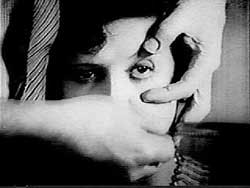Un Chien Andalou
France 1928, 14 min.
Director: Luis Buñuel
Producers: Luis Buñuel, Salvador Dali
Screenwriters: Luis Buñuel, Salvador Dali
Director of Photography: Albert Dubergen
Cast: Pierre Batcheff, Simone Mareuilová, Jaime Miravilles, Salvador Dali, Luis Buñuel.
|

|
In the opening shot of his first film the director himself appears. He is sharpening a razor (a purely masculine instrument), then comes out on the balcony. A cloud acceleratedly (to point out the illusive, imaginative nature of the film medium) passes across the moon. The hero´s perverse association forces us to watch a woman´s eye slit. The initial sequence was inspired by Buñuel´s dream, which by no means can act as an excuse for its shocking brutality. The spectator is injured just like the woman - he is forced to watch, to look with the eye that from now on will bear the stigma of what it has beheld forever. Young creators gave themselves fully to the boundlessness of surrealism - it is as if Luis Buñuel fulfilled his vision of himself as the film creator in the eye sequence. Not to be afraid, to shock, force and injure.
In An Andalusian Dog film becomes a veritable miraculous medium able to materialize dreams, visions and desires. The heroes move in a vicious loop of repeated reincarnations, captured by the fatal and pernicious "love". The miracle of rebirth is given but to them. The spectator has no possibility of erasing what he has seen and beginning anew. The woman´s eye is slit, and in the next scene she is sighted again. This is not true for the spectator though. Unlike the heroine we are traumatized forever. The reality of the "surreal", a space-time which has no constraints and where no laws apply, eventually becomes a tormenting and fettering doom - because of the eternal errance and the impossibility to rest. The last shot, showing the couple trapped in sand, is the most static scene of the film. The magic is gone.
The leitmotif of the film is the relationship between the man and the woman. Their love is pervaded with insanity, obsessions, fatality and death. There is a scene in which they are both staring at a girl run over in the street. The man turns to the woman with an expression of undisguised excitement. Death is the impulse to conjoint, therefore to create new life potentially... Desire is then represented as insanity beclouding reason. With his eyes rolled the man slobbers and furiously grabs the woman´s breasts which become her thighs. To satisfy one´s desire is as gruelling as dragging two pianos with dead cattle, Jesuits and Old Testament boards.
An Andalusian Dog demythologizes society´s moral codes and sexual taboos and discovers the depth of human subconscious mind. Not more than 17 minutes are filled with feverish visions, frustration arising from dissatisfaction, aggressivity, non-repressed instincts and fantasmagorical visions. It is the first triumph of unrestricted fantasy in the history of film, though pathologically influenced by insanity which everyone bears inside himself.
" The goal was to refuse every thought or image having a rational, psychological or generally cultural explanation. To open all windows into the irrational. To use only the pictures that will impress us without even requiring a justification of their presence." L.B.
"Look out of the window as if you were listening to Wagner. Even more pathetically." L.B.´s instruction to Batcheff, the actor in leading role
"An Andalusian Dog is a dreamy cipher of erotic attack." Konrad Eberhardt
Plus:
during the projection of the film two miscarriages occured
one of the Jesuits the hero drags together with the piano is Salvador Dalí
the film music is a mixture of Argentine tangos and Tristan and Isolde
the picture in the book which the heroine throws away is Vermeer´s The Lacemaker
the ants on the palm (an often quoted motif - viz. Démanty noci (Diamonds of Night) by Němec) appeared for the first time in Salvador Dalí´s dream
Links:
screenplay
IMDb - record in the internet film database
other texts related to the film:
Milo Henkrich: Anděl a pes Luise Buñuela (o podobnosti mezi Andaluským psem a Andělem zkázy) [Czech]
[ translation: Sabina Poláková ]
|
|